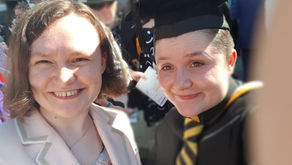Week 10: Case Studies Exploring Trends and Outputs of Influential Studios
- Tramaine Berry
- Aug 2, 2021
- 7 min read
Updated: Sep 27, 2023
Week objectives
Research and analyse the role of designer as author and maker;
Imagine and communicate a series of outputs you could make as an author;
Manage your independent learning effectively.
LECTURE WITH CRAIG OLDHAM //
What's the difference between being a 'designer that writes' and 'a writer that designs'?

Why are you doing this project? Is there an audience? Is it worthwhile? Who are you doing this for - yourself, client or audience?
RESEARCH //
The designer as author
Author - ‘the person who originates or gives existence to anything’; ‘any inventor, constructor or founder’; ‘one who begets’ and ‘a director, commander, or ruler’.
The main theme I'm seeing is 'ownership over the message'. Looking back at the lecture, I didn't understand how you can be an author that designs rather than a designer that writes; however, I now understand that being an author is more than writing, it's about owning your work rather than work being given to you and taking control of the entire project.
One designer that does come to mind is Anthony Burrill, who creates posters using his own phrases. The messages all come from his own life experience, and he tries to make them as truthful as possible. Each one is a result of a conversation, an event or a personal observation.

" I avoid using quotes from other people as I feel they don’t have the personal connection that I look for in my work. I have used other people’s quotes, but these have been in the context of a commission. When I work with other people’s words I try to choose quotes that fit with my own work so that it produces a larger body of work that has a unified message. I believe in what I do, that it has a positive message that other might find useful."
Are Graphic Artists the ultimate authors?
Since authorship is about taking control of the entire project, Im assuming that means having no client involved in the design process, so are graphic artists the ultimate authors?
Other forms of authorship:
A business
Art manifestos (avant-garde, the Situationists, Fluxus and experimental publishing in the 1960s and 1970s)
Concrete poetry
Auteur theory
The Author theory focuses on the idea that the film director is the author of a film. Pauline Kael agues that 'when a director make a good movie, we look at the movie, we don't look at the director's personality'. I can see where she is coming from since within the design industry, people associate a logo with the brand rather than the designer. It is only people within the industry that pay attention to distinct styles of the author.
Webinar
The reader is the author because they interpret those words in different ways -richard nash. Reminds me of anthony b's poster that was misinterpreted. Reinterpret words of someone else makes you an author.
I loved Harriet's project during maternity leave _ look at more maternity projects. The idea of a hobby fuelling your project, learning a new skill for example...always look into doing this. I liked her ma project that uses housewife duties to inform materials in graphic desig
WORKSHOP CHALLENGE: Author and Maker
Find two examples of designers who demonstrate authorial / making expertise in the delivery of a component of their practice. Is it their sole output, are they passion projects or are they opportunities where they saw a gap in the market? Upload onto the Ideas Wall and discuss.
Think about a series of outputs you could make as an author.
Generate 10 ideas for discussion, upload to the Ideas Wall and elaborate further on the blog. Please note, this is the first step of you considering one idea that will be researched and potentially launched as an authorised artefact through the last part of this module.
Designer Examples
Sam Barclay
Sam Barclay uses his own experiences and research to bring viewers into the written world of the dyslexic community; although effort has been made to improve reading abilities, little has been done to create understanding of how it feels. Through research and experience, I know how learning difficulties are still misinterpreted as being of low intelligence, so I think the aim of this book is to spread social awareness.
He created this book 'I wonder what it's like to be dyslexic' as a university project in 2012 and researching the science behind how we read and the structure of the book. He created a kickstarted campaign and found a publisher, where a range of bloggers featuring his third version of the book is published, he created a website to show new content on the subject that may have been missed. Feedback from readers have shown that this book is very engaging for parents with dyslexic children because it allows them to experience what their children go through, so I will need to bear this in mind as a potential audience.
His current practice is in product design in London.

Lucy Grainge
Lucy Grainge is a visual artist and graphic designer from Manchester, U.K. Her work is often community based and research led, visually characterised by a strong use of colour, shape and pattern. Lucy is also a workshop facilitator, delivering a variety of creative subject matter. She is co-founder of Psyche publication, a mental health and socio-politics risograph magazine.
Her collection of books, ‘A Different Way of Brain Processing’ gives a broader understanding of dyslexia, celebrating its diversity rather than seeing it as a disability. By considering both the strengths and challenges dyslexia can create, the aim is to encourage and inspire those with dyslexia, as well as inform those around them. The books were informed by face to face interviews, questionaires, workshops, current research surrounding Dyslexia and her own personal experience.
What outputs can I make as an author?
Based on how I've been building my design identity in the first brief, I think doing a personal project on dyslexia would be relevant to my practice. Because my practise is consultancy based, I would need to consider how I can turn this project into something my different audiences would be interested in (dyslexic employees and job seekers, and employers).
A book
Workshop
A project brief - I could test out the project brief before setting it out to participants.
10 problems and SpLD
Emotion
After experiencing a panic attack from work this week, I thought this would be a project that not only benefits me but other as well.
People need tools to help deal with feelings of anxiety. Groops is a charity for emotional support for dyslexics.
ANXIETY ANGER CHANGE - DIFFICULTY ADJUSTING DEPRESSION and DESPONDENCY EMOTIONAL REGULATION ENVIRONMENTAL AND EMOTIONAL SENSITIVITY FAMILY PROBLEMS FEAR
ISOLATION PANIC ATTACKS P.T.S.D. SELF-IMAGE SHAME, EMBARRASSMENT and GUILT
Relationships
Communicating online - difficult to understand the tone of a text. ‘I get really frustrated when I can’t understand and decode a situation and end up distancing myself from people I’m dating afterwards'
DCDC2 is a dyslexia gene, which means there is a chance the next generation will have dyslexia. Parents could feel guilt for giving their child dyslexia.
Education
A person who has gone through the whole education system, especially without dyslexia being picked up, can grow into an adult who has already had their self-confidence severely dented.
Dyslexics have a right hemispheric or global learning style which means they need an overview and context to learn
Life
Life changing events combined with the inevitable intense emotions that accompany them can cause real confusion and distress for the dyslexic person. These effects could be stress, lack of confidence, anxiety, depression, sadness or anger.
Career
I had this idea since last module, but it is inspired by Barclay's book that shows readers what dyslexics see and this was when I started questioning whether readers would be interested in hearing what dyslexics hear when communicating with people.
Extreme tiredness when having to read and understand text thoroughly as they will need to make much more effort to achieve this than non dyslexics. This becomes an increasing problem as our world of work becomes more 24/7 with the internet, email, texting and the continuous information-sharing opportunities that electronic communication affords.
Short-term memory and verbal instructions
Difficulty with presentations and proof-reading
Employers may feel baffled and annoyed at the inefficiency of the person, resentful that they have to constantly recheck or redo work and find the person's social manner offensive with no obvious explanation. Imposter-syndrome.
Difficulty listening and taking notes at the same time
Performance fluctuates - some days have more severe symptoms than others. This is also known as the roller coaster effect.
Learning new skills
Harriet's idea of using hobbies to fuel your project inspired me to think about my own practice. I always try to learn new skills, but my short term memory gets in the way and I don't have enough time to practise the skill regularly. Is there a way to move past this? I wonder if craft can be used to help with processing emotions.
Reading
Longer to process information and research in study or work.
Health
Food has a connection with dyslexia. Preservatives, Vitamin D and Omega-3 deficiency, Gluten
Entrepreneurship
Difficulty organising thoughts and communicating ideas.
Awkwardness of expression or misuse of words and have difficulties understanding figurative language
10 Ideas for SpLD
Using craft to process emotions
Imposter syndrome in the workplace
Managing panic attacks in the workplace
Learning new skills with short-term memory using global learning style
Performance Fluctuations - I am interested on how symptoms become more intense on certain days. Can we predict what days these are?
Dyslexic fatigue and the processing of information in today's faced-paced era.
Tools to manage entrepreneurship
Being dyslexic and Next of Kin - handling the death of a loved one can be difficult enough when processing emotions, its even worse when you need to sort out paperwork.
Food and Dyslexia
The Dyslexic Gene - DCDC2.
REFLECTION //
I like the idea of communicating how tired dyslexics can get when processing information, especially in today's era of fast-paced information. Additionally, I also like looking at the roller-coaster effect and examine how performance can vary day by day.
REFERENCES //
Research
Rock, M.(1996) ‘The designer as author’, Eye Magazine, Spring. http://www.eyemagazine.com/feature/article/the-designer-as-author
Anthony Burrill: To the Letter. 19 JANUARY 2016. TATE. https://www.tate.org.uk/art/art-terms/p/pop-art/anthony-burrill-letter
Creative Mornings, Anthony Burrill(2017) Make it Now. https://www.youtube.com/watch?v=FuaHeuzqKvE
http://www.grooops.org/wp-content/uploads/2017/02/Dyslexia-Information.pdf
Soames, M. (2008) 17 things we know about Daniel Eatock. Eye Magazine, Winter. http://www.eyemagazine.com/review/article/17-things-we-know-about-daniel-eatock
Kelvyn Smith. http://www.smithsrules.com
It's Nice That, George Hardie, 2016. George Hardie on five decades of illustration. https://www.itsnicethat.com/features/george-hardie-arjowiggins-tooled-up-060416
Lettering Artists David Kindersley and John Neilson. https://www.letteringartstrust.org.uk/artists/browse/john-neilson https://www.bl.uk/events/david-kindersley-alphabetician
Alan Kitching. http://www.thetypographyworkshop.com
Julian House Ghostbox Records.https://ghostbox.co.uk/category/julian-house/ https://www.youtube.com/watch?v=SbWgyc-3eZ0 https://www.youtube.com/watch?v=layt8__N4kY

















Comments